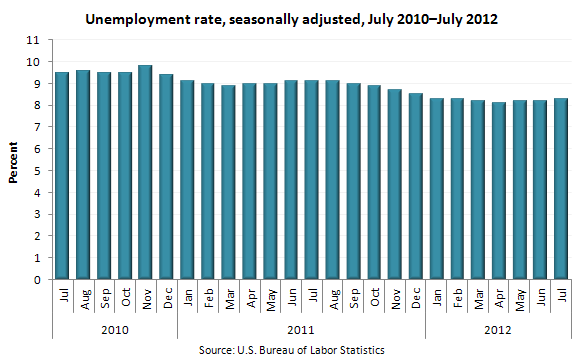August 6, 2012 (The Editor’s Desk is updated each business day.)
Employment and unemployment in July 2012
Nonfarm payroll employment rose by 163,000 in July. Since the beginning of 2012, employment growth has averaged 151,000 per month, about the same as the average monthly gain of 153,000 in 2011.

[Chart data]
In July, employment rose in professional and business services (+49,000), food services and drinking places (+29,000), and manufacturing (+25,000). Employment continued to trend up in health care and in wholesale trade in July. Utilities employment declined by 8,000 in July, reflecting 8,500 workers who were off payrolls because of a labor-management dispute. Employment in other major industries showed little or no change over the month.
Both the unemployment rate (8.3 percent) and the number of unemployed persons (12.8 million) were essentially unchanged in July. Both measures have shown little movement thus far in 2012.

[Chart data]
Among the major worker groups, the unemployment rate for Hispanics (10.3 percent) edged down in July, while the rates for adult men (7.7 percent), adult women (7.5 percent), teenagers (23.8 percent), whites (7.4 percent), and blacks (14.1 percent) showed little or no change. The jobless rate for Asians was 6.2 percent in July (not seasonally adjusted), little changed from a year earlier.
These data are from the Current Employment Statistics and Current Population Survey programs and are seasonally adjusted. Employment data for the most recent two months are preliminary. To learn more, see "The Employment Situation — July 2012," (HTML) (PDF) news release USDL-12-1531. More charts featuring employment data can be found in Current Employment Statistics Highlights: July 2012 (PDF).
Related TED articles
Employment |
Unemployment
Of interest
Spotlight on Statistics: National Hispanic Heritage Month
In this Spotlight, we take a look at the Hispanic labor force—including labor force participation, employment and unemployment, educational attainment, geographic location, country of birth, earnings, consumer expenditures, time use, workplace injuries, and employment projections.
Read more »

